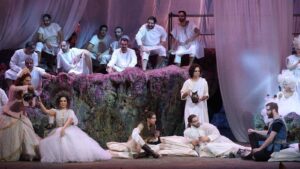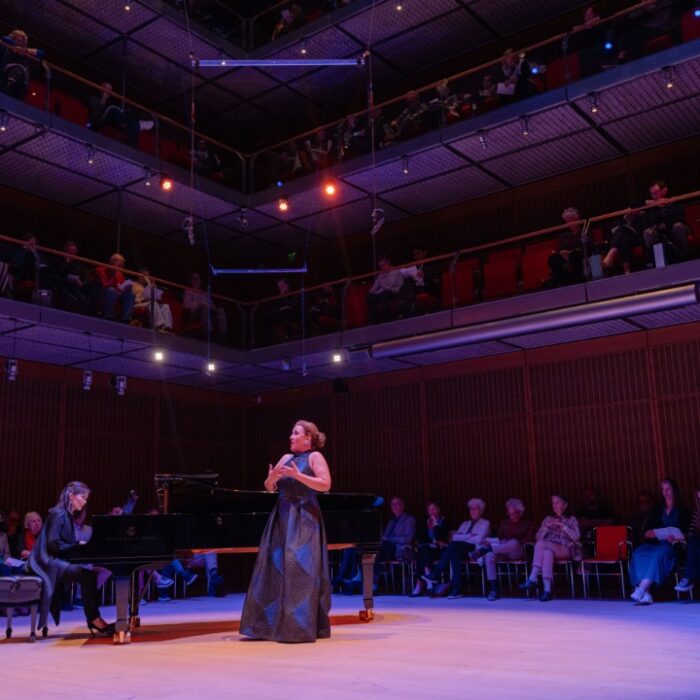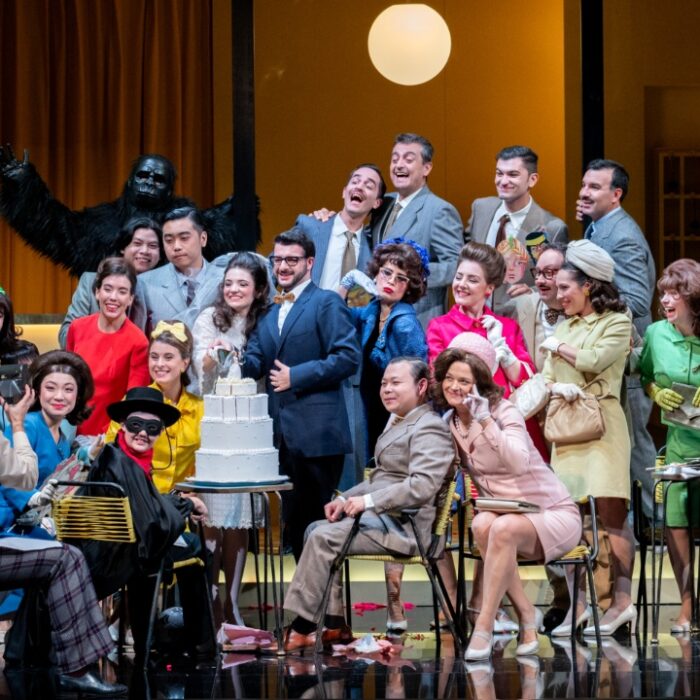
Teatro Real 2022-23 Review: Aquiles en Esciros
Corselli’s score was restored, but the production lacked punch.
By Mauricio VillaA recorded speech before the performance of “Aquiles en Esciros,” explained to the audience that this opera production reached its final stage rehearsals when the pandemic closed down the theatre for months. Not knowing how the situation would develop, the theater kept the sets on the stage for weeks before dismantling them.
The opera composed by Francesco Corselli premiered in Madrid in 1744. But since its premiere, the score had been lost. This production marked the exhaustive work of the Spanish musicologist Alvaro Torrente, who restored and published the score.
“Aquiles en Esciros” at Teatro Real which co-produced the production, directed by Mariame Clément, with Theater an der Wien. But one performance had to be postponed as the two countertenors who played the leading role (Franco Fagioli and Gabriel Díaz) were sick. Fagioli canceled and Gabriel Díaz sang all the performances, including two, one after the other, which was quite demanding for such a long role.
The stage director Mariame Clément placed the whole opera inside a cavern, a unique setting where different elements kept changing for the different scenes, like statues, a white curtain or a boat’s prow. Julia Hansen beautifully designed the realistic sets, cleverly lit by Ulrik Gad. But as with the staging, they became uninteresting after the first hour and the opera was two hours and forty minutes long.
Clément opted for a realistic staging too, but it’s difficult to sustain a baroque opera with the strict structure of recitativo secco and da capo arias with multiple repetitions of the same verse. Naturalistic acting became unreal and flat and therefore did not work to keep the action active and interesting. If a different theatre language is not used to direct the Baroque repertoire, it’s really difficult to make the productions meaningful to the audience today. The staging turns out to be full of “operatic clichés” and an absurd intent to give truth to a musical language which is really distant from the verismo repertoire—which is when operas seek for a believable, meaningful libretto, music and staging.
It was difficult, based on his singing, to tell if Gabriel Díaz had completely recovered from his illness. He played the title role of Aquiles, a long role with seven arias. He possesses a lyrical voice with a warm timbre. His voice and projection grows in his higher register, but unfortunately his voice sounded strident and some high notes were plain. His coloratura was a bit blurred, even when the tempi of his arias was comfortable. His low notes brought a strange change of timbre and color. He was very committed to the staging and was believable as the hero dressed in women’s clothes.
The lirico-leggera soprano Francesca Aspromonte, who performed the role of Deidamia, shined in her arias full of coloratura, trills and intervalic jumps, She opted for interpolating extra high notes in the final cadenzas of the arias showing security and brightness in her upper register.
The Spanish soprano Sabina Puértolas sang the role of Teagene. She has a lirico-leggera voice with a marked vibrato that did not seem entirely comfortable with a central tessitura. She opted for modest variations in the da capo and avoided ascensions to her highest register.
The countertenor Tim Mead performed the role of Ulises, the antagonist of Aquiles. He has only three arias but takes part in sixteen scenes which make his role essential in the drama’s development. He has a sweet timbre, completely even throughout his whole register. His coloratura and roulades were clean and precise.
The Italian bass Mirco Palazzi portrayed Licomede. Palazzi’s voice sounded too lyrical for a part, with several descensions to the lower range of the voice. His low notes lacked projection and presence. He has a clean coloratura technique and could sing the florid passages freely, although he sacrificed his volume and projection during the hardest lines of coloratura. His voice shined in the middle and upper registers.
The participation of the tenor Juan Sancho, as Nearco, was brilliant. With just a single aria, although he sings multiple recitatives, his voice was well projected and imprinted a vocal weight to such a secondary role. His timbre is warm and he can sing long coloratura lines in one breath with a clean resolution and perfect pitch. On the other hand, the tenor Krystian Adam was a timid Arcade, with a guttural sound and small projection.
The musical director of Teatro Real Ivor Bolton, a baroque specialist conducted firmly and with energy. He seemed delighted with every single passage and infuse the score with colours, dynamics and enthusiasm. I am not sure if it was the composition or his interpretation, but the music was lineal. Maybe this was because of the strict baroque structure of recitatives and arias. In fact, there was a feeling of freshness in the few interventions of the choir of the Teatro Real. The Orquesta barroca de Sevilla played with determination and energy.
Unfortunately, the long-awaited “Aquiles en Esciros” at Teatro Real lacked interest and excitement.


